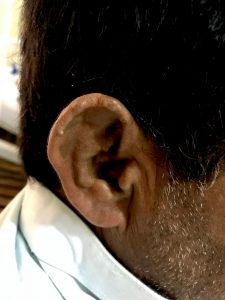A 45-year-old male patient, who presented to the outpatient department of Pakistan Institute of Medical Sciences Islamabad with complaints of progressive lower back pain and stiffness in association with a limitation of mobility for the last 20 years.
The back pain was insidious in onset and progressive in nature associated with early morning stiffness, and only recently had become so severe that it was difficult for him to carry out his daily activities.
Physical examination revealed a bluish pigmentation of the sclera bilaterally. He had bilateral bluish- black pigmentation of the dorsal as well as the palmar surface of his hands and fingernails as well.
Bluish pigmentation and cartilaginous deposits were also found on the auricles of ears.




Question 1: Which bedside test may be helpful in diagnosing this patient?
Question 2: What complications might this patient develop?
Question 3: How would you confirm the diagnosis?
Question 4: How will you manage this case?

Answer key for the above questions is posted below. New visitors should try to solve the questions prior to looking at the answer key.
Question 1: Which bedside test may be helpful in diagnosing this patient?
Answer: Bedside urine examination. Urine will turn black on exposure to air.
Question 2: What complications might this patient develop?
Answer:
- Ankylosis
- Aortic and mitral valvulitis
- Calcifications in coronary artery
- Calcification of lumbar discs
- Osteoarthritis
- Kidney stones
- Prostate stones
Question 3: How would you confirm the diagnosis?
Answer: Alkaptonuria is confirmed via gas chromatography-mass spectroscopy by identifying homogentisic acid in urine
Question 4: How will you manage this case?
- Dietary Modifications: Reduction in the protein-rich diet
- Medical care:
- Vitamin C (Ascorbic Acid 1g/dl)
- Nitisinone (Inhibitor of Enzyme -4-hydroxyphenylpyruvate)

Briefly about alkaptonuria:
Alkaptonuria is an autosomal recessive disorder resulting from a deficiency of homogentisic acid dioxygenase. since homogentisic acid is not oxidized, it polymerizes and gets deposited in various organs.
Bluish-black pigmentation …
As the process of these ochronotic pigment deposition progresses, in the third decade of life it starts manifesting itself. Thus it remains asymptomatic during childhood. These pigments start to appear in the sclera and ear cartilages first.
Joints, Back pain and stiffness …
This is followed by calcification of the vertebral column, with notable pigment deposition in the lumbosacral spine. When joints are affected, it may be misdiagnosed as Rheumatoid or Osteoarthritis. brownish discoloration of the clothes can occur with sweating.
Similarly, cardiac valves and coronary arterial calcification can occur in individuals over 50 years of age.
Diagnosis – Black Urine disease …
Diagnosis is suspected when the urine turns black in the air or after alkalinization. This is due to oxidation of homogentisic acid. The disease acquired the name of “Black Urine Disease” as a result of this process. Homogentisic acid can be measured in body fluids like blood, urine and tissue samples.
Treatment of Alkaptonuria …
No effective therapy is available to treat the disease. Diet should be restricted in tyrosine and phenylalanine (low protein diet). Ascorbic acid is thought to inhibit the polymerization of homogentisic acid but has little role in its treatment.
Nitisinone inhibits the second enzyme in the catabolic pathway and reduces excretion of homogentisic acid into the urine by 95% but has little effect on arthritic symptoms.